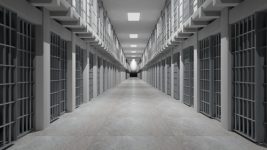A World Without Bars: the Prison Abolition Movement

The transatlantic slave trade existed for well over three hundred years, with European nations abducting millions of people from Africa and taking them to colonies in the Americas to be sold into involuntary servitude.
Indeed, the wealth of the United States was built upon the backs of slaves.
The profits were so lucrative and the practice was so entrenched in people’s minds that the majority blindly went along with this institution that perpetrated immense atrocities and injustices, as though it was an established part of the normal social system that couldn’t be removed.
But gradually, the system of slavery was abolished. The resistance of the enslaved peoples themselves, along with the formation the abolitionist movement saw the trade being outlawed in Britain in 1833, and the practice banned in the US in 1865 under the 13th Amendment of the US Constitution.
Slavery by another name
The walls of prison have been around in some form since the early periods of human history. The idea for modern prisons came from social reformists that were against capital punishment. By the 19th century, large scale gaols were built to house offenders, as well as a means to deter crime.
Today, the United States imprisons more people than any other nation in the world. Over two million of its citizens are held behind bars. It’s the birthplace of the prison industrial complex: a system where the government incarcerates great numbers of disadvantaged people, whist turning a profit via their labour, with the help of private industry.
The broken Australian prison system
The prison population in Australia is ever increasing, while the system itself is failing. As of June last year, there were 38,845 adult prisoners in corrective services custody, taking the national imprisonment rate to 208 inmates per 100,000 adults.
But recidivism rates in this country are nearing 50 percent, meaning close to half all prisoners return to gaol within two years of release. And due to the discriminatory criminal justice system, Indigenous people make up 27 percent of inmates, while they account for only 2 percent of the overall adult population.
The idea that the prison system is a necessary part of society is so ingrained in many people’s minds that they can’t see past it. But there’s a growing movement of individuals who do envisage a society without incarceration. And this is the prison abolition movement.
Pulling down the walls
Abolitionists are working towards the goal of eliminating incarceration, along with policing and the ever encroaching system of mass surveillance, as these forms of control and punishment maintain the oppression and inequalities of the socially disadvantaged.
As many find it hard to conceive of a society without these mechanisms, abolitionists often point to the example of slavery as an entrenched societal system that was eventually eradicated through the thoughts of dissenting voices, and gradual structural change.
Indeed, prominent American abolitionist Angela Davis points to a direct transition from the institution of slavery to that of the prison, where a sizeable amount of the population was once enslaved, they’re now incarcerated.
And so, in the US people of colour make up 60 percent of those imprisoned, but only 30 percent of the overall population.
The Australian prison system is much the same. The most commonly incarcerated people are the socially disadvantaged and marginalised: Indigenous Australians, people of colour, the poor, LGBTIQ people and youths.
There are calls from abolitionists in this country to bring about an end to prisons. Flat Out is independent support and advocacy service for criminalised women and women leaving prison in Melbourne. Since the late 1980s, they’ve been a vocal part of the prison abolition movement both in Australia and internationally.
Where to begin
Chairperson of Flat Out Amanda George told Sydney Criminal Lawyers® that abolitionists are not “saying pull the walls down now.” The process of abolishing the prison system in this country and around the globe would be a “step by step process of decarceration.”
To begin with society needs to take a look at who the people in prison are, their backgrounds and what the basis is of their criminal behaviours. “We as a society need to look at what are the institutions in our society that lead people down a path towards criminalisation,” Ms George outlined.
Take for example criminalised behaviour that’s linked to drugs or alcohol. These are often due to family violence or abuse suffered by the offender when they were a child, George said. If issues like these were addressed, then we would “see a massive reduction in criminalised behaviour.”
According to George, “structural inequalities, like gender, racism, lack of access to education, lack of housing… are intricately involved in who ends up in prison.” And the massive amounts of money the government spends on incarcerating people could be redirected towards social services that addressed these problems.
Decarceration is already occurring
The largest incarcerator in the world, the US, is already releasing inmates. “Because of massive overcrowding there and because of prison budgets going through the roof,” Ms George explained, “you have governments that are now decarcerating because they’re going bankrupt.”
The US Sentencing Commission voted to reduce sentencing guidelines for most drug trafficking offenders in April 2014. This meant that more than 46,000 inmates were eligible to have their cases reviewed, and that penalties would be reduced on average by two years and one month.
Society’s most violent offenders
It’s not hard for most people to conceive of abolishing the practice of imprisoning people for minor offences. And the idea that if appropriate services were implemented in the community then people with mental health issues and substance dependency problems could be helped is well understood.
But when it comes to an offender who goes as far as to murder another person, then those prison walls suddenly appear in people’s minds again.
However, Ms George points out that most women in the community are killed by their partners or ex-partners. And when not killing their partners, most men kill their friends when they’re intoxicated. These are the sorts of behaviours might be addressed through adequate services and education.
This would leave those “terrible crimes of violence that are committed by strangers,” which do occur. However, the actual numbers of these crimes are very low.
A vision for the future
Abolitionists don’t have all the answers yet. But if society invested in large-scale structural changes that addressed social disadvantages, then the crimes caused by these situations would cease to exist, and the prison system would slowly start to become obsolete.
And new approaches for dealing with the issues of those most violent offenders might evolve as society as a whole begins to change.
The advantage of traveling down this path, Ms George explains is that “if we get to a point where we had a massive reduction in the number of prisons and the massive amount of people in them, we will be a happier, healthier society.”
Receive all of our articles weekly
Author

Paul Gregoire






